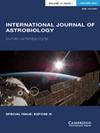Ectogenesis for survival in deep space and deep time: reply to Gale and Wandel
IF 1
4区 物理与天体物理
Q3 ASTRONOMY & ASTROPHYSICS
引用次数: 2
Abstract
Gale and Wandel (2021) describe my paper in IJA (Edwards, 2021) as having crossed the border of scientific plausibility into the realm of ‘science fiction.’ By science fiction, they presumably mean the ‘bad’ kind based on implausible or unsupported scientific concepts, such as time reversal, multiverses and indeed the warp drives of Star Trek they mention. As my paper is based only on current medical and scientific research, it does not make the transgression they imply. In it, I first reviewed artificial uterus systems and embryo cryopreservation as to whether they could potentially be used in space colonization or in recolonizing Earth after mass extinction events. While complete ectogenesis – the development of early-stage embryos to birth entirely outside the natural womb – is not yet available to serve this purpose, in the near future it likely will be (Bulletti et al., 2011; Räsänen and Smajdor, 2020). To illustrate the power and flexibility of the approach, I then discussed how such systems might be deployed in a comprehensive survival plan to handle a variety of extinction events, ranging from brief events in the very near future to the final, total extinction due to solar expansion (Ward and Brownlee, 2003; Klee, 2017). Gale and Wandel direct their criticisms primarily at these example survival missions, not the feasibility of ectogenesis with cryopreserved embryos per se. On one hand, they argue that near-term extinction events could be better handled by establishing colonies on Mars, on Jupiter’s moons or in O’Neill-type space colonies. Such colonies have dim prospects indeed. Recently it was shown, for example, that insufficient CO2 exists in known reservoirs on Mars to enable terraforming (Jakosky and Edwards, 2018), a sine qua non for Martian colonies. Jupiter’s moon Europa has indeed been proposed as a possible candidate for a space colony (e.g., the Artemis Project), but the extremely harsh radiation environment due to Jupiter’s magnetic storms and the ultra-frigid surface conditions there render such a colony as pure fantasy. Gerard O’Neill’s space colonies – city-sized structures holding up to a million people – rely on such notions as harvesting raw materials for manufacturing from the Moon or asteroids and constructing a totally self-supporting internal ecosystem. Such achievements again go far beyond what is technically feasible in the foreseeable future. Moreover, if by some miracle such colonies were in fact built, it would be Earth which would have to continually sustain them, rather than they protecting us from possible extinction. After a major extinction event, the vital connection with Earth for everything from medicines to spare parts would be lost and the colony would quickly collapse. In the model scheme I proposed, however, smaller spacecraft or space stations orbiting the Earth and carrying just a small number of astronauts/colonists would be one of the first lines of defence in short-duration events. These missions could then be extended using ectogenesis to handle events of progressively larger magnitude and longer duration, by substituting embryos first for some and then finally all of the adult crew members. These orbiting missions together with an interlocking, parallel sequence unfolding in subterranean installations would be the simplest and also the most urgent application of ectogenesis to mass extinction survival, a process I termed Embryo Earth Recolonization (EER). While these EER missions would be the most critical ones in terms of human survival, Gale and Wandel save most of their fire for the far more technically challenging missions of exoplanet colonization, previously termed Embryo Space Colonization (ESC). These missions would be needed to avoid extinction events that render Earth permanently inhospitable to life, including the final one due to solar expansion. They first argue that it would be pointless to send out ESC spacecraft now, with existing methods of propulsion, as they would only be overtaken by later generations of spaceships with faster propulsion. In the first place, missions to exoplanets would most likely not be undertaken until many years of experience had first been gained through designing EER missions for mass extinction survival. By that time significant advances in propulsion systems would presumably have been made. More significantly, an advanced civilization that repeatedly delayed sending out ESC ships could run the risk of being obliterated in an extinction event before any ships were launched. On a deeper level, whether the ships are faster or slower does not really matter. Gale and Wandel’s argument that the mechanical systems on ESC ships could not survive for thousands or millions of years would be true: if the systems were running that whole time. As I在深空和时间深处生存的共生:对盖尔和万德尔的回应
Gale和Wandel(2021)将我在IJA (Edwards, 2021)上发表的论文描述为跨越了科学合理性的边界,进入了“科幻小说”的领域。他们所说的科幻小说,大概是指那些基于不可信或不受支持的科学概念的“坏”小说,比如时间逆转、多重宇宙,以及他们提到的《星际迷航》中的曲速引擎。由于我的论文仅基于当前的医学和科学研究,因此并没有他们所暗示的违法行为。在这篇文章中,我首先回顾了人工子宫系统和胚胎冷冻保存是否有可能用于太空殖民或在大规模灭绝事件后重新殖民地球。虽然完全的体外生殖——早期胚胎发育到完全在自然子宫外出生——目前还不能实现这一目的,但在不久的将来可能会实现(bullettti等人,2011;Räsänen and Smajdor, 2020)。为了说明这种方法的力量和灵活性,我随后讨论了如何在一个全面的生存计划中部署这样的系统来处理各种灭绝事件,从不久的将来的短暂事件到最终的,由于太阳膨胀而导致的完全灭绝(Ward and Brownlee, 2003;克利,2017)。Gale和Wandel的批评主要针对这些生存任务的例子,而不是用冷冻胚胎本身进行体外生殖的可行性。一方面,他们认为,通过在火星、木星的卫星或奥尼尔式的太空殖民地上建立殖民地,可以更好地应对近期的灭绝事件。这样的殖民地确实前景黯淡。例如,最近有研究表明,火星上已知储层中存在的二氧化碳不足,无法实现地球化(Jakosky和Edwards, 2018),而地球化是火星殖民地的必要条件。木星的卫星木卫二确实被提议作为太空殖民地的可能候选者(例如,阿尔忒弥斯计划),但由于木星磁暴的极端恶劣的辐射环境和那里超冷的表面条件,使得这样的殖民地纯粹是幻想。杰拉德·奥尼尔的太空殖民地——城市大小的建筑,最多可容纳100万人——依赖于从月球或小行星上收集制造原材料,并建立一个完全自给自足的内部生态系统等概念。在可预见的未来,这些成就再次远远超出了技术上可行的范围。此外,如果奇迹发生,这样的殖民地真的建成了,那将是地球必须继续维持它们,而不是它们保护我们免于可能的灭绝。在一次大灭绝事件之后,从药品到备件,与地球的重要联系将会消失,殖民地将迅速崩溃。然而,在我提出的模型方案中,较小的航天器或空间站绕地球运行,只携带少量宇航员/殖民者,将成为短期事件中的第一道防线之一。然后,这些任务可以通过体外生殖来延长,通过先用胚胎代替一些成年机组人员,然后再用胚胎代替所有成年机组人员,来处理规模越来越大、持续时间越来越长的事件。这些轨道任务连同在地下设施中展开的连锁、平行序列将是外生在大规模灭绝生存中最简单、也是最紧迫的应用,我将这个过程称为胚胎地球再殖民化(EER)。虽然这些EER任务对人类的生存来说是最关键的,但盖尔和万德尔把大部分精力都放在了技术上更具挑战性的系外行星殖民任务上,这些任务以前被称为胚胎太空殖民(ESC)。这些任务将需要避免灭绝事件,使地球永远不适合生命,包括最后一个由于太阳膨胀。他们首先认为,现在用现有的推进方法发射ESC航天器是毫无意义的,因为它们只会被具有更快推进力的后代宇宙飞船超越。首先,在通过设计大规模灭绝生存的EER任务获得多年的经验之前,很可能不会执行外行星任务。到那时,推进系统大概已经取得了重大进展。更重要的是,一个先进的文明,如果一再推迟派遣ESC飞船,就有可能在任何飞船发射之前就在灭绝事件中被消灭。在更深层次上,船是快还是慢并不重要。Gale和Wandel认为ESC船上的机械系统不能存活数千年或数百万年的观点是正确的:如果这些系统一直在运行的话。就像我
本文章由计算机程序翻译,如有差异,请以英文原文为准。
求助全文
约1分钟内获得全文
求助全文
来源期刊

International Journal of Astrobiology
地学天文-地球科学综合
CiteScore
3.70
自引率
11.80%
发文量
45
审稿时长
>12 weeks
期刊介绍:
International Journal of Astrobiology is the peer-reviewed forum for practitioners in this exciting interdisciplinary field. Coverage includes cosmic prebiotic chemistry, planetary evolution, the search for planetary systems and habitable zones, extremophile biology and experimental simulation of extraterrestrial environments, Mars as an abode of life, life detection in our solar system and beyond, the search for extraterrestrial intelligence, the history of the science of astrobiology, as well as societal and educational aspects of astrobiology. Occasionally an issue of the journal is devoted to the keynote plenary research papers from an international meeting. A notable feature of the journal is the global distribution of its authors.
 求助内容:
求助内容: 应助结果提醒方式:
应助结果提醒方式:


